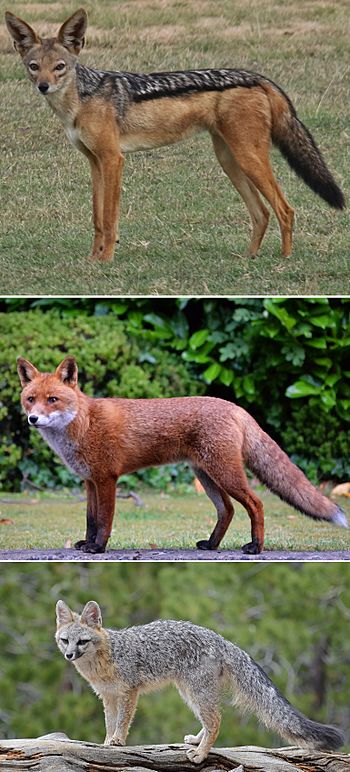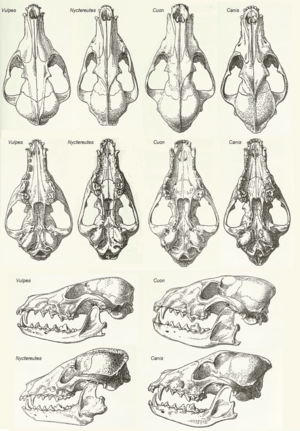Canines facts for kids
Quick facts for kids Canines |
|
|---|---|
 |
|
| Main groups of canines: a black-backed jackal (a true dog), a red fox (a fox), and a gray fox | |
| Scientific classification |
|
| Kingdom: | Animalia |
| Phylum: | Chordata |
| Class: | Mammalia |
| Order: | Carnivora |
| Family: | Canidae |
| Subfamily: | Caninae Fischer de Waldheim, 1817 |
| Genera | |
|
|
Canines are a group of animals that belong to the dog family, called Canidae. This group includes all the dogs, wolves, foxes, and jackals we see today, as well as their closest relatives from the past.
There are three main groups, or subfamilies, in the Canidae family. Caninae is one of them. The other two groups, called Borophaginae and Hesperocyoninae, are now extinct. Scientists first found fossils of canines in North America. These fossils are from the Oligocene era, which was about 34 million years ago. Later, canines spread to Asia, Europe, and Africa around 7 to 8 million years ago.
Contents
The Canine Family Tree
| Canid subfamilies | |||||||||||||||
|
The very first primitive canine was a genus called Leptocyon. This name means "slender dog" in Greek. These early canines were small, weighing only about 2 kilograms (4.4 pounds). They first appeared in Nebraska, USA, about 32 to 34 million years ago.
Leptocyon species were good at catching small, fast-moving prey. One species, L. delicatus, was the smallest canine ever. Around 9 million years ago, some Leptocyon species started to look like modern foxes. About 11.9 million years ago, the Leptocyon family split into two main branches: the Vulpini (foxes) and the Canini (true dogs, wolves, and jackals).
Canines lived in North America for a very long time. Then, about 7 million years ago, they started to spread to Asia, Europe, and Africa. One reason they might have spread so well is that their legs were longer and lighter compared to the extinct canid groups. This made it easier for them to travel far distances.
Types of Canines Today

Scientists study the DNA and chromosomes of animals to understand how they are related. This helps them group canines into different categories:
Wolf-like Canines (Canina)
This group includes animals that look like wolves. Many of them belong to the Canis genus.
- The domestic dog (Canis lupus familiaris) is the most common example.
- Other members are the gray wolf (Canis lupus), red wolf (Canis rufus), eastern wolf (Canis lycaon), and coyote (Canis latrans).
- Jackals are also in this group, like the Eurasian golden jackal (Canis aureus), African golden wolf (Canis anthus), Ethiopian wolf (Canis simensis), black-backed jackal (Canis mesomelas), and side-striped jackal (Canis adustus).
- Other animals here are the dhole (Cuon alpinus) and the African wild dog (Lycaon pictus).
South American Canines (Cerdocyonina)
This group includes many canines found in South America.
- Examples are the bush dog (Speothos venaticus), hoary fox (Lycalopex vetulus), crab-eating fox (Cerdocyon thous), and maned wolf (Chrysocyon brachyurus).
Fox-like Canines (Vulpini)
This group includes many types of foxes.
- Some well-known foxes are the kit fox (Vulpes velox), red fox (Vulpes vulpes), Cape fox (Vulpes chama), Arctic fox (Vulpes lagopus), and fennec fox (Vulpes zerda).
- Other animals in this group are the raccoon dog (Nyctereutes procyonoides) and the bat-eared fox (Otocyon megalotis).
Gray and Island Foxes (Urocyon)
This group is special because it only contains two species: the California island fox (Urocyon littoralis) and the gray fox (Urocyon cinereoargenteus). They are considered very old branches of the canine family tree.
DNA studies show that the wolf-like canines, South American canines, and fox-like canines are all distinct groups. The wolf-like and South American canines together form a larger group called Canini. Scientists believe that all living canids first appeared in North America about 10 million years ago. The wolf-like canines then developed in Africa, with jackals being the oldest members of that group.
The family tree below shows how these different canine groups are related:
| Caninae |
|
|||||||||||||||||||||||||||||||||||||||||||||||||||||||||||||||||||||||||||||||||||||||||||||||||||||||||||||||||||||||||||||||||||||||||||||||||||||||||||||||||||||||||||||||||||||||||||||||||||||||||
See also
 In Spanish: Caninae para niños
In Spanish: Caninae para niños



